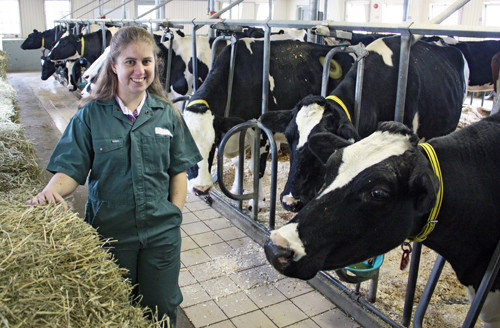
When veterinary professor Jessica Gordon was in private practice, she saw dairy cows suffering from ketosis so frequently that she used the standard treatment of giving a dextrose IV with injected vitamin B12 and steroids plus oral propylene glycol on a daily basis. Only when she came to the Ontario Veterinary College (OVC) and conducted an analysis of ketosis research did she learn that this common approach had actually been shown to make the cows sicker.
“I think that really highlights the importance of research,” she says. “Many people are using handed-down treatments that have zero evidence to support them.”
Gordon first expressed her desire to be a veterinarian when she was eight years old, growing up in Michigan. Her mother assured her she’d change her mind, but Gordon never did. What did change was her focus: she initially assumed she would be caring for cats and dogs, but discovered an interest in food animals during her undergraduate work in animal science at Michigan State University. After completing her DVM, she moved to Wisconsin and worked in private practice for three years, treating primarily dairy cows plus some beef cattle, sheep and goats.
When she ran into OVC professor Stephen Leblanc at a conference, he mentioned to her that there were some openings in the D.V.Sc. program. Gordon was familiar with OVC because she had done a rotation there during her Michigan State studies, and was pleased to be able to have Leblanc and Prof. Todd Duffield as her co-advisers. She graduated with a D.V.Sc. in ruminant-health management in July and was hired as a faculty member in September 2013.
Gordon’s thesis work looked at dairy cows during what is called “the transition period” when cows are at the highest risk of disease: from three weeks before calving to three weeks after the calf is born. During this time, the cow experiences many physical changes as her body goes through the demands of late pregnancy, the birth of the calf and the initiation of milk production. Making milk, especially in the large volumes that modern dairy cows produce, can be very stressful and requires a significant output of energy. When cows don’t take in enough energy, their bodies begin to break down body fats, causing ketones to appear in their milk, urine and blood. This condition is called ketosis.
The average lactational incidence of ketosis is 40 per cent, although it varies from farm to farm. For some cows the effects are fairly mild, but for others it can be serious or even fatal. Gordon adds that the condition has been recognized and studied for nearly 100 years, and many treatments have been tried, yet solid research has been lacking. For her thesis, she began her research by doing a systematic review, but of the 1,400 studies she examined, only 10 were actually well done according to her parameters. “It was shocking to see how terrible much of the research was,” she says.
Based on the evidence in the best research, Gordon conducted two large treatment trials with 700 cows in each. The first group of sick cows received propylene glycol, the treatment with the best evidence supporting its use. “It’s basically a source of energy,” she says. Some cows also received either a B12 and phosphorus product or insulin along with the propylene glycol; some received all three. The results showed that insulin was not helpful at all, but the B12 and phosphorus improved ketosis resolution and increased milk production.
With those results in mind, Gordon’s next trial set out to determine how long the treatment should be given. Half of the sick cows in this trial were given propylene glycol plus the B12 and phosphorus compound for three days; the others received it for five days. She found that the cows with higher ketone levels benefited more from the five days of treatment, while those with lower levels did not see any additional benefit after three days.
“We also found something new,” says Gordon. “The effective duration of treatment also depended on blood glucose levels.” Cows with lower blood glucose get more benefit from longer treatment than cows with higher levels, even if their ketone levels were the same. This unexpected new finding wasn’t seen in other studies and gives researchers a new avenue to look at to better understand ketosis. Gordon would like to do a follow-up study to monitor the day-by-day changes in ketones and blood glucose.
That study will need to wait: her current research is on intestinal parasites in beef cattle. Any animals that graze in fields are prone to getting parasites, Gordon explains, and some can become quite ill. This study looks at two different classes of drugs commonly used to treat parasites and will measure three outcomes: evidence of parasite resistance to the drug, the effectiveness of the drug in reducing parasite counts and how the weight of the calves at weaning is affected.
Gordon’s husband works at an agricultural equipment dealership, and they share a love of antique tractors – they currently own three. He’s a licensed pilot as well, and they both love to fly. Gordon spends much of the cold weather with her nose in a novel, but when the weather warms up she and her husband like to hike and enjoy nature. They are currently renting a farm but hope to purchase one soon so they can have their own herd of beef cattle.